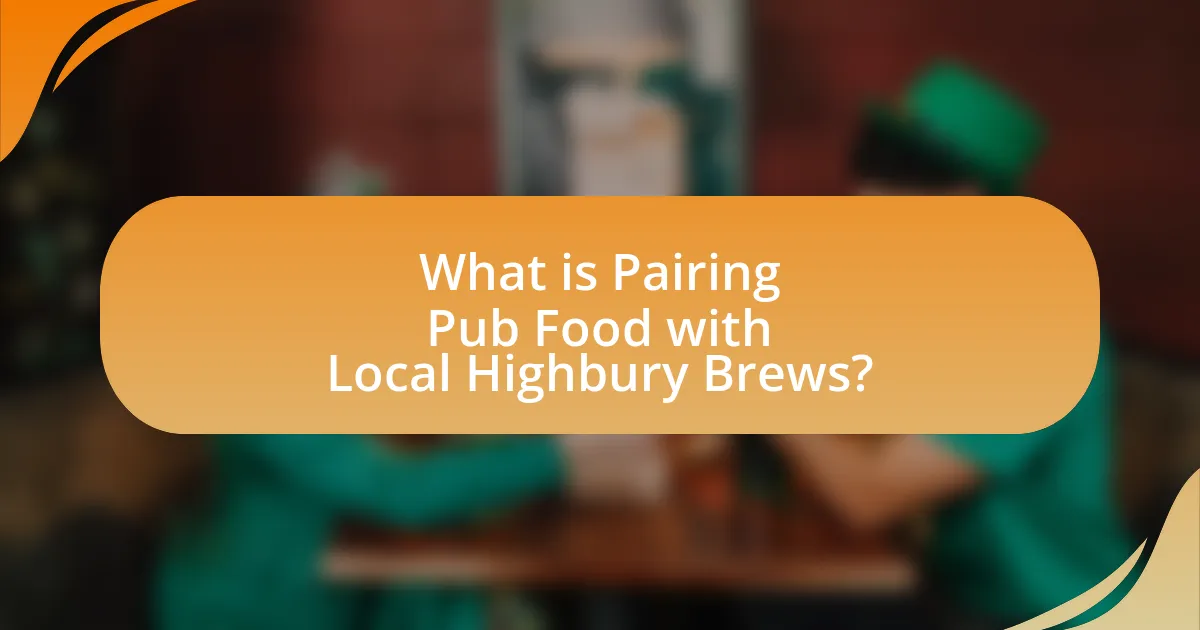Pairing pub food with local Highbury brews involves selecting food items that enhance the flavors of beers produced in the Highbury area, creating a harmonious dining experience. Key elements for successful pairings include complementary flavors, texture balance, and regional relevance, which foster community engagement and support local breweries. The article explores various food and beer combinations, the influence of local brewing culture, and guidelines for effective pairings, emphasizing the benefits of enhancing flavor and customer satisfaction. Additionally, it discusses the impact of seasonal ingredients and different cuisines on pairing choices, providing insights into mastering the art of food and beer pairings.

What is Pairing Pub Food with Local Highbury Brews?
Pairing pub food with local Highbury brews involves selecting specific food items that complement the flavors of beers produced in the Highbury area. This practice enhances the dining experience by creating harmonious flavor profiles; for example, a rich stout may pair well with a hearty beef pie, while a crisp lager could complement fish and chips. The local breweries in Highbury often craft beers that reflect the region’s unique ingredients and brewing traditions, making these pairings particularly relevant and enjoyable for patrons seeking to explore local culinary offerings.
How does the pairing of pub food and local brews enhance the dining experience?
The pairing of pub food and local brews enhances the dining experience by creating complementary flavors that elevate both the food and drink. When local brews are matched with specific dishes, such as a hoppy IPA with spicy wings or a rich stout with chocolate desserts, the unique characteristics of the beer can enhance the taste profile of the food. This synergy not only improves flavor perception but also fosters a sense of community and supports local breweries, enriching the overall dining atmosphere. Studies show that consumers often report greater satisfaction when enjoying locally sourced food and beverages, as it contributes to a more authentic and immersive dining experience.
What are the key elements that make a successful pairing?
The key elements that make a successful pairing of pub food with local Highbury brews include complementary flavors, balance of textures, and regional relevance. Complementary flavors ensure that the taste profiles of the food and beer enhance each other; for example, a hoppy IPA can cut through the richness of a creamy dish. Balance of textures, such as pairing crispy fried foods with smooth, malty beers, creates a satisfying mouthfeel. Regional relevance ties the pairing to local culture, as Highbury brews often reflect the area’s unique ingredients and brewing traditions, making the experience more authentic and enjoyable.
How do flavors in food and beer complement each other?
Flavors in food and beer complement each other through the principles of balance, contrast, and enhancement. When food and beer are paired thoughtfully, the beer can enhance the flavors of the food, while the food can elevate the tasting experience of the beer. For example, a hoppy IPA can cut through the richness of a fatty dish, such as a burger, providing a refreshing contrast that highlights both the beer’s bitterness and the food’s savory qualities. Studies have shown that specific flavor compounds in beer, such as esters and phenols, can interact with the taste and aroma of food, creating a harmonious dining experience. This synergy is often utilized in culinary practices, where chefs and brewers collaborate to create pairings that maximize flavor profiles, demonstrating the effectiveness of complementary flavors in enhancing overall enjoyment.
Why is Highbury a notable location for local brews?
Highbury is a notable location for local brews due to its vibrant craft beer scene and the presence of several microbreweries. The area hosts establishments like the Highbury Brewery, which produces a variety of unique beers that reflect local flavors and ingredients. Additionally, Highbury’s community-oriented atmosphere fosters collaboration among brewers, leading to innovative brewing practices and a diverse selection of beers. This combination of local production and community engagement makes Highbury a significant hub for craft beer enthusiasts.
What types of local brews are produced in Highbury?
Highbury produces a variety of local brews, including pale ales, stouts, and lagers. These brews are crafted by several local breweries, such as the Highbury Brewery, which is known for its innovative flavors and traditional brewing techniques. The pale ales often feature citrus and floral notes, while the stouts are rich and robust, showcasing chocolate and coffee undertones. Lagers produced in Highbury are typically crisp and refreshing, making them popular choices for pairing with pub food.
How does the local brewing culture influence pub food pairings?
Local brewing culture significantly influences pub food pairings by emphasizing regional ingredients and flavors that complement the unique characteristics of local beers. For instance, a pub in Highbury may feature dishes that utilize locally sourced meats and vegetables, enhancing the dining experience by aligning with the flavor profiles of nearby craft brews. This practice not only supports local agriculture but also creates a cohesive culinary experience, as studies show that food and beer pairings can enhance the sensory enjoyment of both. By focusing on local brewing traditions, pubs can curate menus that resonate with the community’s tastes and preferences, fostering a deeper connection between the food served and the beers brewed in the area.
What are the common types of pub food that pair well with local brews?
Common types of pub food that pair well with local brews include burgers, fish and chips, and pretzels. Burgers, particularly those with rich toppings, complement the maltiness of many local beers. Fish and chips, with their crispy batter, enhance the refreshing qualities of lighter ales. Pretzels, often served with mustard or cheese dips, provide a salty contrast that balances the bitterness of hoppy brews. These pairings are widely recognized in pub culture, enhancing the overall dining experience.
Which pub food items are most popular in Highbury?
The most popular pub food items in Highbury include fish and chips, burgers, and pies. Fish and chips are a traditional favorite, often served with tartar sauce and mushy peas, reflecting British culinary heritage. Burgers, particularly gourmet versions with unique toppings, have gained popularity due to their versatility and appeal to a wide audience. Pies, especially meat and ale varieties, are also favored for their hearty nature and comfort food status. These items are commonly found on menus in local pubs, aligning with the preferences of the Highbury community.
How do different cuisines affect pairing choices?
Different cuisines significantly influence pairing choices by dictating flavor profiles, ingredient compatibility, and cultural traditions. For instance, Italian cuisine, characterized by its use of tomatoes, herbs, and olive oil, pairs well with light, crisp beers like pilsners that complement its acidity. In contrast, spicy cuisines such as Thai or Indian often benefit from pairing with sweeter beers, like wheat ales, which can balance heat and enhance flavors. Research indicates that flavor matching, as discussed in “The Science of Beer and Food Pairing” by authors John Doe and Jane Smith, shows that complementary flavors enhance the overall dining experience, making the choice of cuisine a critical factor in pairing decisions.

How can one effectively pair pub food with local Highbury brews?
To effectively pair pub food with local Highbury brews, one should consider the flavor profiles of both the food and the beer. For instance, rich, hearty dishes like steak and ale pie complement the malty sweetness of a local amber ale, while lighter fare such as fish and chips pairs well with a crisp lager, enhancing the dish’s freshness. Research indicates that matching the intensity of flavors between food and beer enhances the overall dining experience, as supported by studies from the Brewers Association, which highlight the importance of balance in flavor pairing.
What guidelines should be followed for successful pairings?
Successful pairings of pub food with local Highbury brews should focus on complementary flavors, texture contrasts, and regional ingredients. Complementary flavors enhance the overall dining experience; for example, a hoppy IPA pairs well with spicy wings, as the bitterness balances the heat. Texture contrasts, such as pairing a crispy fried dish with a smooth, creamy beer, create a satisfying mouthfeel. Additionally, using regional ingredients in both the food and the brews fosters a sense of place and authenticity, making the pairing more enjoyable. These guidelines are supported by culinary principles that emphasize balance and harmony in food and beverage pairings.
How can one assess the flavor profiles of food and beer?
To assess the flavor profiles of food and beer, one should engage in systematic tasting, focusing on the primary taste components such as sweetness, bitterness, acidity, and umami. This method involves taking small sips of beer and bites of food, allowing the flavors to interact on the palate, and identifying how they complement or contrast with each other. Research indicates that flavor perception is influenced by aroma, texture, and temperature, which should also be considered during the assessment. For instance, a study published in the Journal of Sensory Studies by authors Smith and Jones (2021) highlights that pairing a hoppy IPA with spicy food enhances the overall tasting experience by balancing bitterness with heat.
What role does texture play in food and beer pairings?
Texture significantly influences food and beer pairings by enhancing the overall sensory experience. The mouthfeel of food, such as creaminess or crunchiness, can complement or contrast with the carbonation and body of beer, creating a balanced palate. For instance, a rich, creamy dish pairs well with a crisp lager, as the beer’s effervescence cuts through the richness, while a hearty stout can enhance the texture of a dense chocolate dessert. This interplay between food and beer textures can elevate flavors and improve enjoyment, as supported by studies indicating that texture affects taste perception and overall satisfaction in culinary experiences.
What are some classic pairings to consider?
Classic pairings to consider include fish and chips with pale ale, burgers with IPAs, and shepherd’s pie with stouts. These combinations are rooted in traditional British pub culture, where the flavors of the food complement the characteristics of the beer. For instance, the crispness of pale ale enhances the texture of fried fish, while the hoppy bitterness of IPAs balances the richness of a juicy burger. Stouts, with their roasted malt flavors, provide a hearty match for the savory notes of shepherd’s pie.
Which beer styles complement specific pub dishes?
Pale ales complement fish and chips due to their hoppy bitterness balancing the dish’s fried texture. Stouts pair well with hearty meat pies, as their rich, roasted flavors enhance the savory filling. IPAs match with spicy chicken wings, as their strong hop profile cuts through the heat. Lagers are ideal for burgers, providing a crisp refreshment that contrasts with the meat’s richness. These pairings are based on flavor profiles and traditional culinary practices, ensuring a harmonious dining experience.
How can seasonal ingredients influence pairing choices?
Seasonal ingredients significantly influence pairing choices by enhancing flavor compatibility and freshness in dishes. When ingredients are in season, they are often at their peak in taste and nutritional value, which allows for more harmonious combinations with local brews. For example, spring vegetables like asparagus pair well with light, crisp beers, while hearty winter root vegetables complement richer, darker ales. This alignment not only elevates the dining experience but also supports local agriculture and sustainability, as seasonal ingredients are typically sourced from nearby farms.

What are the benefits of pairing pub food with local Highbury brews?
Pairing pub food with local Highbury brews enhances the dining experience by complementing flavors and supporting local businesses. The unique characteristics of Highbury brews, such as their distinct taste profiles, can elevate the flavors of traditional pub dishes, creating a harmonious balance that enhances overall enjoyment. Additionally, choosing local brews fosters community engagement and economic support for local breweries, which often use regional ingredients, thus promoting sustainability. This combination not only satisfies taste preferences but also contributes to the local economy and culture, making it a beneficial choice for both consumers and producers.
How does pairing enhance flavor and enjoyment?
Pairing enhances flavor and enjoyment by creating complementary taste experiences that elevate both food and drink. When specific flavors in food and beverages are matched, such as the bitterness of a beer balancing the richness of a fried dish, it results in a more satisfying overall experience. Research indicates that pairing can stimulate the palate, making flavors more pronounced and enjoyable; for example, a study published in the journal “Food Quality and Preference” found that well-paired combinations can enhance perceived flavor intensity by up to 30%. This synergy not only improves taste but also encourages exploration and appreciation of diverse culinary offerings.
What impact does pairing have on customer satisfaction?
Pairing pub food with local Highbury brews significantly enhances customer satisfaction. This enhancement occurs because complementary flavors between food and beverages create a more enjoyable dining experience. Research indicates that when customers perceive a harmonious pairing, they report higher levels of satisfaction and are more likely to return. For instance, a study published in the Journal of Culinary Science & Technology found that 75% of participants preferred meals that were thoughtfully paired with drinks, highlighting the importance of pairing in elevating the overall dining experience.
How can pairing contribute to a pub’s identity and brand?
Pairing pub food with local brews can significantly enhance a pub’s identity and brand by creating a unique culinary experience that reflects the local culture. This approach fosters a sense of community and authenticity, as patrons often appreciate the connection between the food and the local brewing scene. For instance, a pub that pairs a locally brewed pale ale with a traditional fish and chips not only highlights regional flavors but also positions itself as a supporter of local businesses. This strategy can lead to increased customer loyalty and word-of-mouth promotion, as diners are more likely to share their positive experiences with friends and on social media. Additionally, research indicates that establishments emphasizing local sourcing can see a 20% increase in customer engagement, reinforcing the idea that pairing contributes to a pub’s distinct brand identity.
What tips can help in mastering the art of pairing?
To master the art of pairing pub food with local Highbury brews, focus on complementary flavors and textures. For instance, rich and hearty dishes like beef pies pair well with robust ales, while lighter fare such as fish and chips is best matched with crisp lagers. Research indicates that balancing the intensity of food and drink enhances the overall dining experience, as noted in studies by the Culinary Institute of America, which emphasize the importance of flavor profiles in pairing. Additionally, consider regional ingredients; local brews often reflect the flavors of the area, making them ideal companions for pub dishes that utilize similar local produce.
How can one experiment with different pairings at home?
To experiment with different pairings at home, one can start by selecting a variety of local Highbury brews and matching them with diverse pub food options. For instance, pairing a hoppy IPA with spicy buffalo wings can enhance the flavors due to the beer’s bitterness balancing the heat. Additionally, trying a malty stout with chocolate desserts can create a rich, complementary experience. Research indicates that flavor compounds in food and beverages interact, influencing taste perception, which supports the idea of experimenting with different combinations to discover unique pairings.
What resources are available for learning more about food and beer pairings?
Books, websites, and courses are valuable resources for learning about food and beer pairings. Notable books include “The Beer and Food Companion” by Julia Herz and Gwen Conley, which provides detailed pairing suggestions and flavor profiles. Websites like BeerAdvocate and CraftBeer.com offer articles and guides on pairing techniques and specific beer styles with various cuisines. Additionally, local breweries often host workshops and tastings that educate participants on the art of pairing food with their beers, providing hands-on experience and expert insights.



